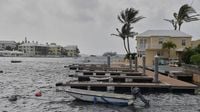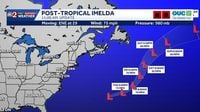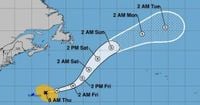Hurricane Imelda swept past Bermuda in the early hours of October 2, 2025, leaving a trail of downed trees, power outages, and battered coastlines, but—remarkably—no reported injuries or significant structural damage. The Category 2 hurricane, which narrowly missed a direct landfall on the British island territory, brought with it a stark reminder of the Atlantic hurricane season’s unpredictability and power, even as the season begins to wind down.
According to the Associated Press, Imelda’s core skirted Bermuda, unleashing hurricane-force wind gusts that toppled trees and power lines, while lashing the island with heavy rain and dangerous surf. At the storm’s peak, up to 18,000 customers lost power—a significant figure for the small territory—but restoration efforts began swiftly as conditions improved. By Thursday afternoon, crews were fanning out across the island to assess and repair the damage, and the international airport had reopened, albeit with schools and government offices still shuttered for safety.
Premier David Burt offered a note of relief amid the chaos, stating, “There has been no significant damage and, most importantly, no reported casualties.” This sentiment was echoed by National Security Minister Michael Weeks, who urged residents to remain sheltered while crews worked to restore normalcy. “With this unsettled weather, we’re asking that people still remain sheltered and stay safe,” Weeks advised, as reported by the AP.
Imelda’s approach was met with robust preparedness. On October 1, Bermuda closed schools, offices, and the airport, deploying 100 soldiers to secure infrastructure, clear roads, and assist at emergency shelters. The quick mobilization of resources and the community’s compliance with safety directives were credited with helping the island avoid more severe outcomes.
As Imelda moved away from Bermuda, it weakened from Category 2 to Category 1, with maximum sustained winds dropping to 80 mph. By late morning on October 2, the National Hurricane Center (NHC) reported the storm had transitioned to a post-tropical cyclone, located about 315 miles east-northeast of Bermuda and moving east-northeast at 29–30 mph. The NHC’s advisory noted that Bermuda was no longer under a tropical storm warning, and conditions on the island were expected to improve rapidly, with clearing skies anticipated for the morning sunrise—perfect timing for damage assessment and restoration efforts.
But the story of Imelda didn’t end at Bermuda’s shores. Earlier in the week, the hurricane had battered the northern Caribbean, causing widespread flooding in eastern Cuba and Haiti. In Cuba, two people tragically lost their lives, while in Haiti, one person was reported missing and two others injured, according to both the AP and USA TODAY. The storm’s reach extended well beyond its immediate path, generating dangerous surf and life-threatening rip currents along the north Caribbean, Bahamas, Bermuda, and much of the U.S. East Coast. These hazardous conditions were expected to persist, with the NHC warning that swells would spread to the Greater Antilles and northern Leeward Islands by October 3, likely causing further risk to coastal communities.
Imelda’s impact was compounded by the recent passage of Hurricane Humberto, which had raced ahead of Imelda before dissipating west of Bermuda on October 1. The remnants of Humberto, named Storm Amy by U.K. forecasters, were predicted to affect Ireland and the U.K. starting Friday, October 3, bringing further unsettled weather to the North Atlantic region.
Despite the disruption, Bermuda’s resilience shone through. The rapid reopening of the international airport and the restoration of power to thousands signaled a return to normalcy, even as forecasters urged continued vigilance. Alex DaSilva, AccuWeather’s lead hurricane expert, cautioned, “We expect atmospheric conditions that could support tropical storms and hurricanes well into late October and November this year.” The Atlantic hurricane season, after all, officially runs from June 1 to November 30, and 2025 was predicted by the U.S. National Oceanic and Atmospheric Administration (NOAA) to be an above-normal year, with 13 to 18 named storms and five to nine hurricanes, including two to five major hurricanes packing winds of 111 mph or greater.
As the NHC downgraded Imelda to an extratropical system over the central Atlantic, it continued monitoring two additional disturbances in the Atlantic basin. One area of low pressure was expected to approach the northwestern Bahamas and southern Florida by October 4, though it had only a low chance of developing into a tropical system. Another tropical wave forming in the Central Tropical Atlantic was also being watched, with a 20% chance of development over the next week. Meanwhile, in the Eastern Pacific, Tropical Storm Octave was spinning with winds of 65 mph, and a trough of low pressure off the coast of southern and southwestern Mexico had a high likelihood—up to 90% over the next seven days—of forming into a tropical depression.
For those living in hurricane-prone regions, the week’s events served as a timely reminder of the importance of preparation. The NOAA recommends that residents develop evacuation plans, assemble disaster supplies, check their insurance coverage (especially for flood damage, which isn’t covered by standard home or renters insurance), and create family communication plans. “Get your disaster supplies while the shelves are still stocked, and get that insurance checkup early, as flood insurance requires a 30-day waiting period,” the NOAA advises.
Hurricanes, as meteorologists often explain, are born over warm tropical waters when clusters of thunderstorms begin to swirl, eventually developing into the powerful systems that can threaten coastlines thousands of miles away. While Imelda has now moved on, its legacy is a testament to both the destructive potential of these storms and the resilience of communities like Bermuda, which once again weathered the tempest with determination and preparedness.
As the Atlantic hurricane season continues, eyes remain on the tropics, with meteorologists and residents alike watching for the next storm to emerge from the swirling Atlantic waters. For now, Bermuda can breathe a sigh of relief, but the lessons of Imelda—and the storms before her—linger on, urging vigilance and respect for nature’s unpredictable power.



